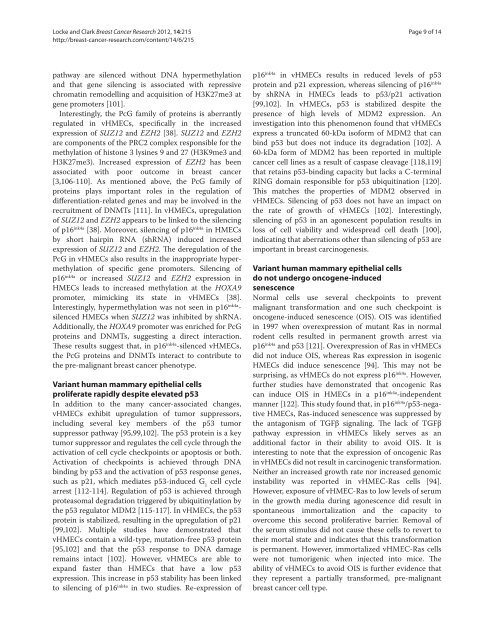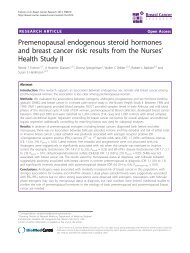PDF - Breast Cancer Research
PDF - Breast Cancer Research
PDF - Breast Cancer Research
You also want an ePaper? Increase the reach of your titles
YUMPU automatically turns print PDFs into web optimized ePapers that Google loves.
Locke and Clark <strong>Breast</strong> <strong>Cancer</strong> <strong>Research</strong> 2012, 14:215<br />
http://breast-cancer-research.com/content/14/6/215<br />
Page 9 of 14<br />
pathway are silenced without DNA hypermethylation<br />
and that gene silencing is associated with repressive<br />
chromatin remodelling and acquisition of H3K27me3 at<br />
gene promoters [101].<br />
Interestingly, the PcG family of proteins is aberrantly<br />
regulated in vHMECs, specifically in the increased<br />
expression of SUZ12 and EZH2 [38]. SUZ12 and EZH2<br />
are components of the PRC2 complex responsible for the<br />
methylation of histone 3 lysines 9 and 27 (H3K9me3 and<br />
H3K27me3). Increased expression of EZH2 has been<br />
associated with poor outcome in breast cancer<br />
[3,106-110]. As mentioned above, the PcG family of<br />
proteins plays important roles in the regulation of<br />
differentiation-related genes and may be involved in the<br />
recruitment of DNMTs [111]. In vHMECs, upregulation<br />
of SUZ12 and EZH2 appears to be linked to the silencing<br />
of p16 ink4a [38]. Moreover, silencing of p16 ink4a in HMECs<br />
by short hairpin RNA (shRNA) induced increased<br />
expression of SUZ12 and EZH2. The deregulation of the<br />
PcG in vHMECs also results in the inappropriate hypermethylation<br />
of specific gene promoters. Silencing of<br />
p16 ink4a or increased SUZ12 and EZH2 expression in<br />
HMECs leads to increased methylation at the HOXA9<br />
promoter, mimicking its state in vHMECs [38].<br />
Interestingly, hypermethylation was not seen in p16 ink4a -<br />
silenced HMECs when SUZ12 was inhibited by shRNA.<br />
Additionally, the HOXA9 promoter was enriched for PcG<br />
proteins and DNMTs, suggesting a direct interaction.<br />
These results suggest that, in p16 ink4a -silenced vHMECs,<br />
the PcG proteins and DNMTs interact to contribute to<br />
the pre-malignant breast cancer phenotype.<br />
Variant human mammary epithelial cells<br />
proliferate rapidly despite elevated p53<br />
In addition to the many cancer-associated changes,<br />
vHMECs exhibit upregulation of tumor suppressors,<br />
including several key members of the p53 tumor<br />
suppressor pathway [95,99,102]. The p53 protein is a key<br />
tumor suppressor and regulates the cell cycle through the<br />
activation of cell cycle checkpoints or apoptosis or both.<br />
Activation of checkpoints is achieved through DNA<br />
binding by p53 and the activation of p53 response genes,<br />
such as p21, which mediates p53-induced G 1<br />
cell cycle<br />
arrest [112-114]. Regulation of p53 is achieved through<br />
proteasomal degradation triggered by ubiquitinylation by<br />
the p53 regulator MDM2 [115-117]. In vHMECs, the p53<br />
protein is stabilized, resulting in the upregulation of p21<br />
[99,102]. Multiple studies have demonstrated that<br />
vHMECs contain a wild-type, mutation-free p53 protein<br />
[95,102] and that the p53 response to DNA damage<br />
remains intact [102]. However, vHMECs are able to<br />
expand faster than HMECs that have a low p53<br />
expression. This increase in p53 stability has been linked<br />
to silencing of p16 ink4a in two studies. Re-expression of<br />
p16 ink4a in vHMECs results in reduced levels of p53<br />
protein and p21 expression, whereas silencing of p16 ink4a<br />
by shRNA in HMECs leads to p53/p21 activation<br />
[99,102]. In vHMECs, p53 is stabilized despite the<br />
presence of high levels of MDM2 expression. An<br />
investigation into this phenomenon found that vHMECs<br />
express a truncated 60-kDa isoform of MDM2 that can<br />
bind p53 but does not induce its degradation [102]. A<br />
60-kDa form of MDM2 has been reported in multiple<br />
cancer cell lines as a result of caspase cleavage [118,119]<br />
that retains p53-binding capacity but lacks a C-terminal<br />
RING domain responsible for p53 ubiquitination [120].<br />
This matches the properties of MDM2 observed in<br />
vHMECs. Silencing of p53 does not have an impact on<br />
the rate of growth of vHMECs [102]. Interestingly,<br />
silencing of p53 in an agonescent population results in<br />
loss of cell viability and widespread cell death [100],<br />
indicating that aberrations other than silencing of p53 are<br />
important in breast carcinogenesis.<br />
Variant human mammary epithelial cells<br />
do not undergo oncogene-induced<br />
senescence<br />
Normal cells use several checkpoints to prevent<br />
malignant transformation and one such checkpoint is<br />
oncogene-induced senescence (OIS). OIS was identified<br />
in 1997 when overexpression of mutant Ras in normal<br />
rodent cells resulted in permanent growth arrest via<br />
p16 ink4a and p53 [121]. Overexpression of Ras in vHMECs<br />
did not induce OIS, whereas Ras expression in isogenic<br />
HMECs did induce senescence [94]. This may not be<br />
surprising, as vHMECs do not express p16 ink4a . However,<br />
further studies have demonstrated that oncogenic Ras<br />
can induce OIS in HMECs in a p16 ink4a -independent<br />
manner [122]. This study found that, in p16 ink4a /p53-negative<br />
HMECs, Ras-induced senescence was sup pressed by<br />
the antagonism of TGFβ signaling. The lack of TGFβ<br />
pathway expression in vHMECs likely serves as an<br />
additional factor in their ability to avoid OIS. It is<br />
interesting to note that the expression of oncogenic Ras<br />
in vHMECs did not result in carcinogenic transformation.<br />
Neither an increased growth rate nor increased genomic<br />
instability was reported in vHMEC-Ras cells [94].<br />
However, exposure of vHMEC-Ras to low levels of serum<br />
in the growth media during agonescence did result in<br />
spon taneous immortalization and the capacity to<br />
overcome this second proliferative barrier. Removal of<br />
the serum stimulus did not cause these cells to revert to<br />
their mortal state and indicates that this transformation<br />
is permanent. However, immortalized vHMEC-Ras cells<br />
were not tumorigenic when injected into mice. The<br />
ability of vHMECs to avoid OIS is further evidence that<br />
they represent a partially transformed, pre-malignant<br />
breast cancer cell type.






